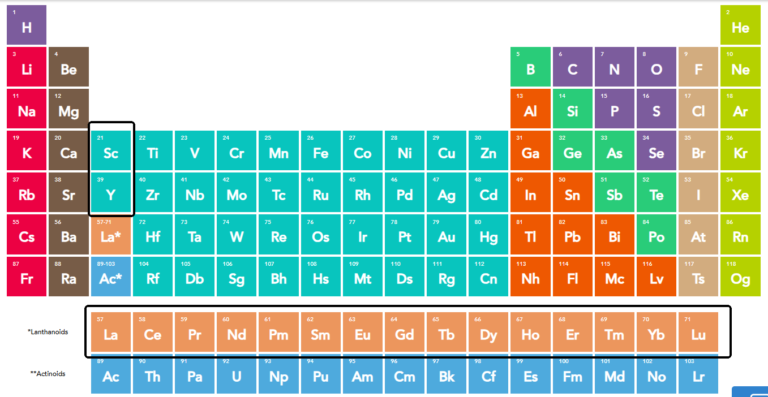Rare earths are not just a type of soil, but rare minerals and extremely important resources. Rare earth refers to 17 rare elements including lanthanum, cerium, praseodymium, neodymium, promethium, samarium, europium, gadolinium, etc.
How were rare earths discovered?
The discovery of rare earths began in the late 18th century, when an insoluble solid oxide was called “earth.” Although rare earths are inherently abundant, they are commonly isolated in the form of oxides, making extraction and purification difficult. As a result, they appear to be in short supply, hence the name “rare earths”. The 17 rare earth elements were not discovered at the same time. From the discovery of yttrium in 1794 to promethium in 1947, this process spanned 153 years. Countries such as China, Russia, the United States, and Australia hold major positions in rare earth resource reserves.
How are rare earths classified?
Rare earths can be classified based on various criteria.
by atomic number
Light rare earth elements: Lanthanum (LA), Cerium (CE), Praseodymium (PR), Neodymium (ND), Promethium (PM).
Heavy rare earth elements: samarium (SM) to lutetium (Lu) including Yttrium (Y).
Features:
Lighter rare earths are more common and widely used in large-scale industrial applications, while heavier rare earths are relatively rare and suitable for high-tech fields.
by mineral source
Rare earths of the monazite type: These are mainly light rare earth elements, especially cerium and lanthanum, which are widely used in abrasive powders and catalysts.
Xenotime-Type Rare Earths: Rich in Yttrium and other heavy rare earth elements, primarily used in high-temperature superconducting materials and lasers.
Rare earths of the fluorocarbonate type: predominantly light rare earths with high cerium and lanthanum contents in ores used in magnetic materials and chemical catalysts.
by chemical form
Rare earth oxides: The most common chemical form of rare earth elements, known for their stability and used primarily in catalysts and ceramic materials.
Rare earth metals: Refined rare earth metals have high electrical conductivity and specific magnetic properties that are used in alloy manufacturing (e.g. magnesium and aluminum alloys).
Rare Earth Compounds: Include rare earth halides and hydrides that are highly chemically active and are used in lasers and optical materials.
Rare earths as “vitamins of industry”
This nickname is due to its unique properties. Rare earths have excellent physical properties such as optical, electrical, and magnetic properties. They can be combined with other materials to create new materials with diverse properties. The most notable feature of rare earths is their ability to significantly improve the quality and performance of other products. For example, it significantly improves the tactical properties of steel, aluminum alloys, magnesium alloys, and titanium alloys used in tanks, aircraft, and missiles. In addition, rare earths are also lubricants in various high-tech fields, such as electronics, lasers, the nuclear industry, and superconductors. Rechargeable batteries, cell phones, computer memory, and DVDs all rely on rare earth elements for proper functioning.
Unique properties:
Magnetic: Neodymium, praseodymium, and samarium are used to produce high performance permanent magnetic materials.
Catalyst: Cerium and lanthanum are important components of automotive exhaust purification catalysts.
Optical performance: Europium, terbium, and yttrium are essential as light-emitting materials for displays and LEDs.
Rare earth oxides or processed rare earth concentrates can be used as polishing powders, widely applied to optical glasses, eyeglass lenses, cathode wire tubes, oscilloscopes, flat glasses, plastics and metal supplies. With the addition of rare earth oxides, optical glasses and special glasses can be produced for various purposes, such as infrared-transmitting glass, ultraviolet-absorbing glass, acid-resistant glass, heat-resistant glass, and X-ray shielding glass.
Apart from industrial uses, rare earths also play a role in agriculture. Extensive research has shown that rare earth elements, when used in appropriate concentrations, enhance nutrient uptake, conversion, and utilization by plants.
Use of 17 rare earth elements
Lanthanum: Used in alloying materials and agricultural films.
Cerium: Widely applied in auto glass.
PRASEODIUM: Widely used in ceramic pigments.
Neodymium: Widely used in aerospace materials.
Promethium: Provides supplemental energy to the satellite.
Samarium: Used in nuclear reactors.
Europium: Used in lens manufacturing and LCD screens.
Gadolinium: Applied in medical MRI imaging.
Terbium: Used in aircraft wing regulators.
Erbium: Used in military laser range finders.
Dysprosium: Used as a lighting source for film and printing.
Holmium: Used in the production of optical communication devices.
Thulium: Applied in clinical diagnosis and tumor treatment.
Ytterbium: Additive for computer memory components.
Lutetium: Used in energy battery technology.
Yttrium: Used in wire manufacturing and aircraft structural components.
Scandium: Commonly used in alloy production.
conclusion
Rare earth metals are ubiquitous and often overlooked, yet they are silent drivers shaping the technological, industrial, and environmental landscape.


